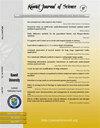Quantifying the impact: Statistical analysis of weather and paddy activities on paddy effluent quality
IF 1.1
4区 综合性期刊
Q3 MULTIDISCIPLINARY SCIENCES
引用次数: 0
Abstract
Paddy cultivation is a cornerstone of global agriculture and food production while supporting rural economies worldwide. Nonetheless, the intensive farming methods have adversely impacted water quality due to the poor effluent quality. The objective of this study is to investigate the influence of weather conditions in terms of precipitation and stages of paddy farming activities on the quality of effluent discharged from paddy fields. A holistic approach was applied to integrate the paddy activities and weather variability into the analysis, uncovering nuanced relationships that have previously been overlooked. The water quality parameters, including biochemical oxygen demand (BOD), ammoniacal nitrogen (NH3–N), total suspended solids (TSS), total phosphorus (TP), total nitrogen (TN), arsenic (As), and aluminium (Al), were comprehensively assessed with statistical methods such as t-tests and analysis of variance (ANOVA). The implementation of statistical methods such as t-tests and ANOVA provides a robust framework for quantifying these relationships and determining their significance. Results showed that the stages of paddy farming activities influenced all the measured water quality parameters statistically significantly, with p-values less than 0.05 obtained for all the parameters. The weather conditions did not significantly influence the quality of the paddy fields effluent. However, the effect of weather conditions with the combination of paddy farming activities is statistically significant towards NH3–N, TSS, and Al with a p-value less than 0.05. This research contributes valuable insights to the scientific understanding of paddy agriculture's environmental footprint and informs evidence-based policies for promoting sustainable agriculture and preserving water quality worldwide. By understanding how weather patterns and farming practices impact effluent quality, strategies to mitigate environmental risks and optimize water management practices in paddy cultivation areas can be developed.
量化影响:天气和稻田活动对稻田出水水质的统计分析
水稻种植是全球农业和粮食生产的基石,同时也支持着全球农村经济。尽管如此,集约化耕作方法由于污水质量差而对水质产生了不利影响。本研究的目的是探讨天气条件在降水和水田耕作活动的阶段对水田排放的污水质量的影响。采用整体方法将水稻活动和天气变化整合到分析中,揭示了以前被忽视的微妙关系。采用t检验和方差分析等统计方法对生化需氧量(BOD)、氨态氮(NH3-N)、总悬浮物(TSS)、总磷(TP)、总氮(TN)、砷(As)、铝(Al)等水质参数进行综合评价。t检验和方差分析等统计方法的实施为量化这些关系和确定其重要性提供了一个强大的框架。结果表明,水稻种植活动阶段对各水质参数的影响均有统计学意义,各参数的p值均小于0.05。气象条件对稻田出水水质影响不显著。而天气条件与水稻种植活动相结合对NH3-N、TSS和Al的影响具有统计学意义,p值均小于0.05。本研究为科学理解水田农业的环境足迹提供了有价值的见解,并为促进全球可持续农业和保护水质提供了基于证据的政策。通过了解天气模式和耕作方式如何影响污水质量,可以制定减轻环境风险和优化水稻种植区水管理实践的战略。
本文章由计算机程序翻译,如有差异,请以英文原文为准。
求助全文
约1分钟内获得全文
求助全文
来源期刊

Kuwait Journal of Science
MULTIDISCIPLINARY SCIENCES-
CiteScore
1.60
自引率
28.60%
发文量
132
期刊介绍:
Kuwait Journal of Science (KJS) is indexed and abstracted by major publishing houses such as Chemical Abstract, Science Citation Index, Current contents, Mathematics Abstract, Micribiological Abstracts etc. KJS publishes peer-review articles in various fields of Science including Mathematics, Computer Science, Physics, Statistics, Biology, Chemistry and Earth & Environmental Sciences. In addition, it also aims to bring the results of scientific research carried out under a variety of intellectual traditions and organizations to the attention of specialized scholarly readership. As such, the publisher expects the submission of original manuscripts which contain analysis and solutions about important theoretical, empirical and normative issues.
 求助内容:
求助内容: 应助结果提醒方式:
应助结果提醒方式:


